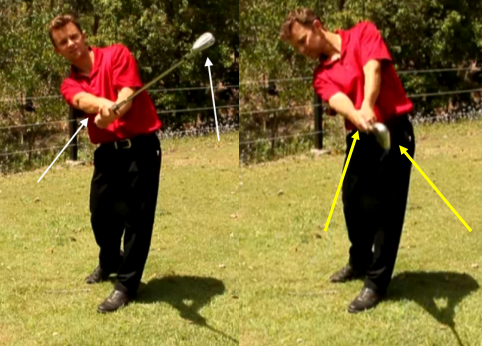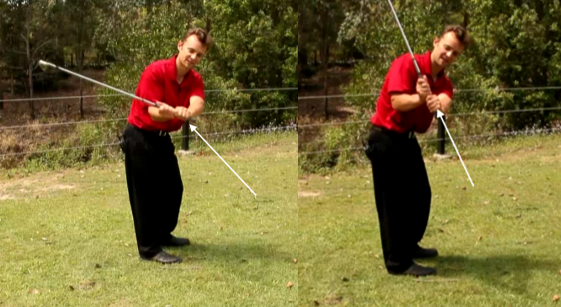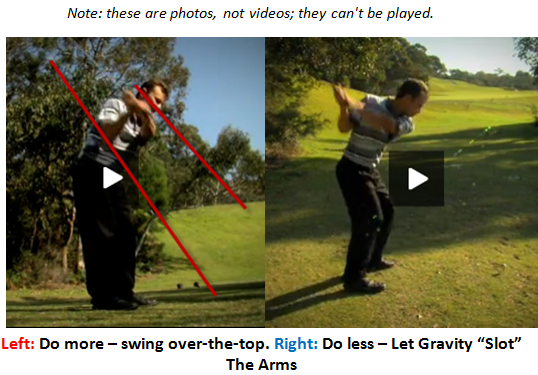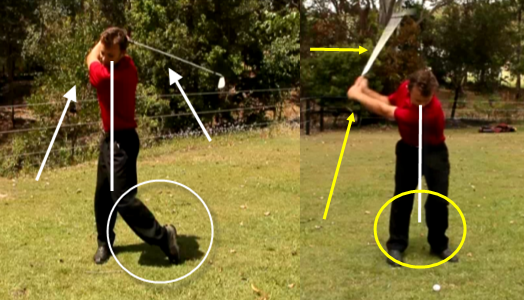Written by Anthony, creator of AP GOLF.
I spent a long time as an average ball-striker because of a few (common) wrong moves that I made in my swing (I see them in so many players). I had a Kids Golf Swing.
A child’s easy going swipe-at-the-ball attitude is something you want, but to get closer to your potential, you have to evolve your Kids Swing into a strong, repeatable Adults Swing.
Sitting down a few years ago I pulled apart my ball-striking and the swing I have now and compared it to the inferior Kids Swing I used to have. Subsequently, I published the results to my subscribers.
Nowadays, I join my pre-shot process of think, see, feel swing with a solid technique. You need both to maximize your golf…You want to Train It, then Trust It.
[Train it – in practice, and Create Shots with it on the course. Golf demands all sorts of ball-flights that come from slightly different swings with different clubs. The think, see, feel, swing (TSFS) fuels your swing to create the shots: high, low, soft, left to right or right to left. The CREATE Shots Training Course covers this.)How do you know if you have a Kids or Adults Golf Swing?
I have not seen a club-golfer with a handicap of six or more with a fully functioning Adults Swing. The lower your handicap the more mature your swing is. The higher your handicap the more elements (that are mentioned below) of the Kids Swing you possess. The more Kids Swing elements you mature out of (by practicing), the better your ball-striking and scoring will become.
Later in this article I will run through what Kids Swing-Faults. Recognize which ones you possess and work on fixing them and maturing towards a fully functioning Adults Golf Swing.
How will developing an Adults Swing affect scoring?
When I was a young trainee in the late 90’s and trying to become a master putter, the lowest score I could shoot was 3 to 4 under par – a few times/year (that’s with taking just 23-24 putts). Now, I can shoot at least 7 under par with 25 putts (that can be lowered by a couple shots – one day!), and I have shot 5 and 6 under par for 9 holes a few times.
These low scores are only achieved once in a while, however, when you have a fully functioning Adults Swing your average score is lowered – so you are permanently playing at a higher level. Let’s take a look at the Kid Swing attributes and shots that result.
Frequent pulls, pushes, hooks, slices, thin and fat shots stem from a Kids Swing.
Kids Golf Swing Fault 1 and 2: The wrists and hands roll flat on the backswing and roll a lot through impact (left).
Commonly, the lead arm and hand rolls leaving the shaft flat and clubface open (back of lead hand looks skyward; see second photo down the page). This rolling on the backswing leads to a corresponding rolling of the hands and clubface through impact.

In a repeating Adults Golf Swing your wrists are more passive, they roll less on the takeaway (they hinge up, not horizontally – after the first three feet of the swing). Through impact, they extend square down the line without rolling as much as in the Kids Swing.
You are less consistent with a rolling Kids-release. The clubface stays square to the target longer in an Adults-release. More rolling requires greater timing which decreases consistency.
The off-plane, half-way-back position
I had this common off-plane move which kept my club open (see below). As mentioned above, if you roll the club-face open in the first half of the backswing it has to roll a lot back to square it up.
Moving the ball too-much right-to-left is a common fault of low handicappers – up to mid-teen handicappers. Excellent striker’s swings are neutral; they can hit it very straight and additionally, by simply seeing and feeling the ball flight they want (high, low, left to right, right to left), they can create the shot with instinctive swing-programming.

Small Fixes
I worked on a neutral takeaway for quite a while, it made things better, but I also worked on a wide swing, which was a mistake (stretching too wide in the back-swing leads to many problems, like being too flat, tense, and moving your center off the ball too much).
I wore a glove on my left hand for a couple of years while pacifying my left-hand-roll in the takeaway. This helped me feel firm in the left hand which helped me reduce the rolling of the hand on the takeaway.
As I look back at this period, I used this key: “keep [back off] left hand looking at the target longer”. This is a simple, non-technical way to reduce the top-hand roll skywards, in the takeaway). Three quarters back it will look out perpendicular to you instead of at the sky.
Kids Golf Swing Fault 3: Your swing could be too loose and long
This is not talked about much, but it has been a huge part of me becoming a solid ball-striker, and I know it will help many club-golfers.
Almost every great golfer has shortened their swing over time. Thinking off the top of my head, these greats won MAJORS after shortening their swings:
- Ben Hogan (9)
- Kel Nagle (British Open – 1960, an Aussie)
- Greg Norman (1993 British Open)
- Davis Love the 3rd
- Nick Faldo (won 6 majors after shortening and tightening his swing)
- Tiger Woods started winning majors in 1997 with a shortened swing which Butch Harmon engineered
- Phil Mickelson’s swing became tighter than in his early Major-less years (coached by Butch Harmon then)
- Nick Price won majors after tightening his swing under David Leadbetter
- John Daly (ha ha, got you! nothing short about JD’s swing)
Other major championship winners who always used a 3/4-swing for short to mid irons and a less than full swing on woods include:
- Byron Nelson
- Lee Trevino
- Tom Kite
- Ian Woosnam
- Wayne Grady
- Sandy Lyle
- Tom Lehman
- Tony Jacklin
- Jon Rahm
I know swinging back less than full has helped me…when I feel 3/4 and in-the-rails (on-plane), the ball goes to the target

Kids Golf Swing Fault 4: Not Centered/Unbalanced

Pin-seeking 9 iron (right)
When swinging, many club-golfers move around too much; their feet come off the ground excessively and many move their heads around too much.
Another one of my faults that I had for years was that I had too much weight on my right side (a fault due to not hitting the ball high as a kid). I was not centered.
Some golfers have the opposite problem, they never get back onto the right side. You must be a little bit behind the ball so your head can be behind the ball at impact while your weight is shifting to the left side through impact (as you would when throwing a ball, a punch, or serving in tennis).
Here is how you know whether you are centered or not, or if you are moving around too much:
- You get extremely annoyed when you receive a bad lie (because you can’t make precise impact)
- You don’t hit it cleanly from fairway bunkers consistently (same as above – extremely hard to make precise contact)
- You can’t hit a solid half or punch-shot
- Your ball flight is not “penetrating”, meaning, the wind affects it greatly (and you move the ball a lot from right-to-left or left-to-right)
- You hit fat shots often
When I was moving about and didn’t have a precise angle of attack into the ball, I couldn’t properly execute the above shots consistently.
When you are balanced and doing less in your swing, drawing a poor fairway-lie or having to hit a fairway-bunker-shot with a 4-iron doesn’t intimidate you. As the great Moe Norman said, “don’t let the lie play you”, meaning, don’t get angry or use a rushed, scared, aggressive swing in reaction to a poor lie, view the lie as an OPPORTUNITY to get MORE centered, have BETTER tempo, and make a PURE golf swing.”
Kids Golf Swing Fault 4: Floppy Arms or Overextension
Groove the correct arm-width for tempo, balance and swing-control.
I went from long arms and floppy (kids) wrists in the first 10 years of my career, to, too firm with the wrists and too wide with the arms. Nowadays, I have a good blend or wrist-hinge with relaxed-arm width, its a simpler more repeatable swing.
Do you hit thin-shots with wedges, can’t play long-irons or fairway bunker shots well?
As mentioned above, 3/4 and 1/2 shots, low shots into the wind, long irons, hitting from bare lies and fairway-bunker shots require precise contact and the golfer being able to make different length swings (less than full) with the corresponding different swing-tempos.
These shots reveal the truth about your swing. If you can’t hit them consistently, refinement is required.
Check-list to move from a Kids Golf Swing to an Adults Golf Swing
DO NOT:
- over extend your arms
- open the club-face with your hands/wrists on the takeaway and get off plane, they should be passive (but wrists must also hinge enough)
- move off the ball much, stay centered
- swing too far (keep it 3/4; this is helped by implementing points 1 & 2)
*Practise half and 3/4 shots. It is vital to master if you want to step up and develop an Adults Swing. You can not execute these shots well, when unbalanced and not in control of your swing.
In summary, to grow out of a Kids Golf Swing and into a fully functioning Adults Golf Swing – which will help you hit straighter, stronger, cleaner golf shots consistently, you will need:
- A neutral takeaway with the correct vertical hinging of the wrists and correct neutral release through the ball
- Correct swing length and arm extension
- Dynamic Balance and Tempo
“For many golfers, better striking and swinging will be achieved by doing less in the swing…less rolling, less wide, less long, more centered.”
